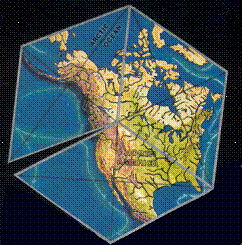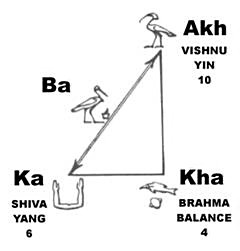EARTHSTAR - USA OVERVIEW
by Bethe Hagens
bethehagens@gmail.com
2007 - Earth Star - USA Overview
Since 2005, I have taught creative thinking and problem solving in the online School of Public Policy at Walden University, a U.S. institution within the huge international corporate conglomerate of Laureate Education, Inc. (formerly Sylvan Learning). My goal has been to bring the experience of geomantic/geometric/mythic thinking-rather than specific content-into the educational arena for students in fields very different from my own. Walden attracts doctoral candidates who are for the most part international, middle management, public policy, social services, or military professionals. The avenues that EarthStar provides for weaving quality of life insights across cultures, ethnicities, geography, and religion have worked well in "residency seminars" that I have offered.
This is one of the handouts I used at our recent Annual Social Change Conference.
The EarthStar world map was developed in the early 1980s by Bethe Hagens and Bill Becker as a university project in environmental design. Imagine Earth as the largest example of geometric patterns found at every scale of matter. How might insights at one scale, in one academic discipline, apply at another size or field of study? For example, what can the architecture of an embryo tell us about the structure of carbon or the design of an Imax dome? How might the sacred numbers and mystical properties associated with divine mythological figures be used to understand geography and engineering? These are just some of the questions about "earth energies" that EarthStar inspires.
The "grid lines" of EarthStar are a spherical geometric net over the entire earth. Hagens describes the energy of this net as the resonant power of beauty, the power of dreaming the web of Earth life "as above, so below" and in that way harnessing creative energy to solve real world problems.

The EarthStar is made up of 120 identical right triangles. In theory, the topographical and even cultural characteristics to be found at similar triangle "corners" are broadly analogous.
A fun way to begin exploration of lines and corners in the United States is to look at corners using the Egyptian and Hindu "mythological template triangle" below.

Notice, for example, that Shiva-a Hindu divinity who makes love on a hexagonal bed-is linked to an intersection of six triangles. Shiva is dark, powerful, and earthy. These EarthStar corners are often associated with rich resources. Notice that Vishnu, another Hindu divinity often represented as a fish and with the number 10, is matched with intersections of ten triangles. These EarthStar corners most often fall in the ocean. The Great Pyramid in Egypt falls at an EarthStar intersection of four corners. How might the four-corner EarthStar intersections at Valdez (Alaska), Hudson's Bay, and the Sea of Cortez be comparable to the Nile Delta?
Bethe Hagens, Ph.D., Faculty, School of Public Policy & Administration, Walden University
These files are protected by a Creative Commons license. Any of the information and graphics may be copied and freely shared as long as (1) the author and source are cited; (2) the Creative Commons license is acknowledged; and (3) the material is not sold. Please contact me if you have a question about using any of these materials.